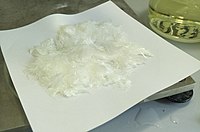
Photo from wikipedia
To prevent global warming caused by the burning of fossil fuels, the formation of metal organic framework materials (i.e., MOFs) is a promising approach for efficient and scalable CO2 adsorption… Click to show full abstract
To prevent global warming caused by the burning of fossil fuels, the formation of metal organic framework materials (i.e., MOFs) is a promising approach for efficient and scalable CO2 adsorption from air. In this study, a novel stable layered bis-phosphonate MOF, i.e., MIL-91(Al), has been synthesized for adsorption of CO2 under ambient conditions. XRD, N2 adsorption–desorption isotherms, FTIR and HRTEM were employed to characterize the synthesized MIL-91(Al). The results show that MIL-91(Al) demonstrates an excellent adsorption performance for CO2 (i.e., the maximum adsorption can reach up to 2.4 mmol g−1) and a relatively high selectivity for CO2vs. other gases (e.g., N2 or CH4). Moreover, the adsorption behavior of CO2 onto the surface of MIL-91(Al) has also been investigated using in situ diffuse reflectance infrared Fourier transform spectroscopy (in situ DRIFTS). The DRIFTS results show that CO2 can be adsorbed by both the free polar groups (N⋯H–OP) and the Al–OH–Al bond. The special adsorption behavior is caused by the layered structure of MIL-91(Al) which leads to the exposure of Al on the surface.
Journal Title: New Journal of Chemistry
Year Published: 2018
Link to full text (if available)
Share on Social Media: Sign Up to like & get
recommendations!